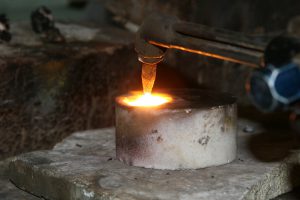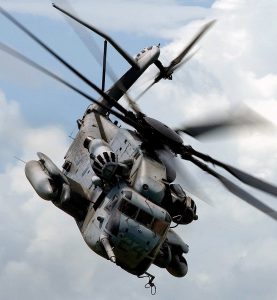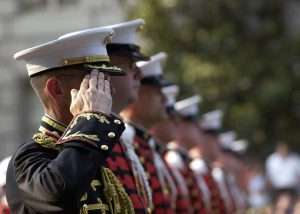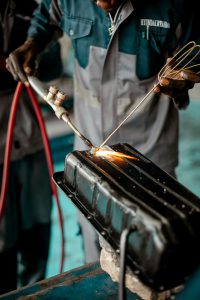Every piece of military equipment, from tanks to transport carriers, has hardworking welders behind them.
Why the Military Needs Welders
Welders in the military build and maintain military equipment. Their tasks vary depending on which branch of the military they join. Common duties of military welders include:
- Repairing damaged equipment
- Maintaining military structures
- Crafting military equipment parts
- Maintaining safety standards
- Perform metal shop calculations

Types of Military Support Welders
Welders need to fine-tune their skills to suit the branch of the military that they’re serving in. Here are what paths a military welder can take:
Air Force Welder
Want a big career? There’s nothing bigger than the planes built by aircraft metal technology welders. These welders design and weld lane parts. Their eye for detail and well-crafted blueprints ensures that the parts they craft are safe to use.Army Welder
Even the sturdiest pieces of equipment can fall into disrepair. Luckily, allied trade specialists can be counted on to keep army equipment running. They use metal shop equipment to fabricate and modify metal equipment.

Coast Guard Welder
Ships need to be watertight before they carry military personnel and equipment. Damage controlmen ensure ship stability by welding emergency equipment to counter flooding and fires.Marine Welder
MOS 1316 metalworkers weld the backbones that marines rely on. The Marines need savvy planners who aren’t afraid to take charge. Their constant inspections and recordkeeping ensure that what they create is safe to use.Navy Welder:
Navy steelworkers don’t just build their careers. They build their team when they weld bridges, towers, and steel plates. They also do repair work in areas struck by natural disasters.
Military Welding: A Step-by-Step Career Guide
Ready to serve your country? Here’s what you need to do to gain the skills your country needs:
- Graduate High School
Welders need a high school degree or equivalent. Math and science have useful background information for welders.
- Attend Welding School
You’re not required to attend welding school to enlist, but it stands out to recruiters. Welding programs give you the skill to create durable metal pieces.

- Take the ASVAB Test
The military requires recruits to take the Armed Services Vocational Battery (ASVAB) test. This test analyzes your behavior and skills to determine which branch of the military you’re suited for.
The ASVAB has ten sections of multiple-choice questions. Aspiring welders need to focus on the general maintenance (GM) and general technical (GT) sections.
- Enlist
In addition to passing the ASVAB, military welders must also meet military physical and moral requirements.
Accepted recruits must also attend basic training. Military welders don’t regularly see combat, but they are expected to have the same discipline and understanding of teamwork as their fellow military recruits.
- Attend Advanced Individual Training
You’ll fine-tune your welding skills at Advanced Individual Training (AIT). This 13-week program will teach you more about military-specific welding. Upon completion of the program, you’ll be ready to be the welder your fellow military needs you to be.
What You’ll Learn in Welding Trade School
Why attend welding school if you’re going to train in welding upon enlistment?
Because a months-long program is more in-depth than a 13-week one. If you complete a welding program, you’ll come into the military confident in your ability to create strong welds. At a welding training program, you’ll master these welding techniques:

GMAW Welding
Metal Inert Gas (MIG) welding forms an arc between a metal piece and a wire electrode. This generates metals that melt the parts to make them fuse together. This method uses a shielding gas to protect the metal from damage. Military support welders use MIG welding to construct and maintain buildings.GTAW Welding
Tungsten inert gas (TIG) welding relies on a tungsten electrode that’s heated up by a wire. The electrode bonds objects together without relying on a filler metal. An inert gas shields the electrode and the weld puddle. These create strong welds that can be used in plane and tank constructions.FCAW Welding
The advantage of flux-cored arc welding (FCAW) welding is that it can be used outside. This is because a flux compound inside the electrode protects the weld pool instead of relying on gas. This is a technique that Navy shipbuilders rely on.SMAW Welding
This method connects a metal rod to a power source to form the weld. Electricity passes between the metals and the flux rod creates a gas to protect from outside contamination.
Build the Skills You Need at ETI’s Welding School
Do you want to be the strongest welder you can be?
There’s no better way to strengthen your techniques than with hands-on training. That’s what you’ll get at ETI’s welding training program. If you want to practice on updated equipment under the guidance of experienced instructors, you’ve come to the right place.
Visit our website for more information.
Learn more about Welding Career:
 (888) 830-7678
(888) 830-7678


